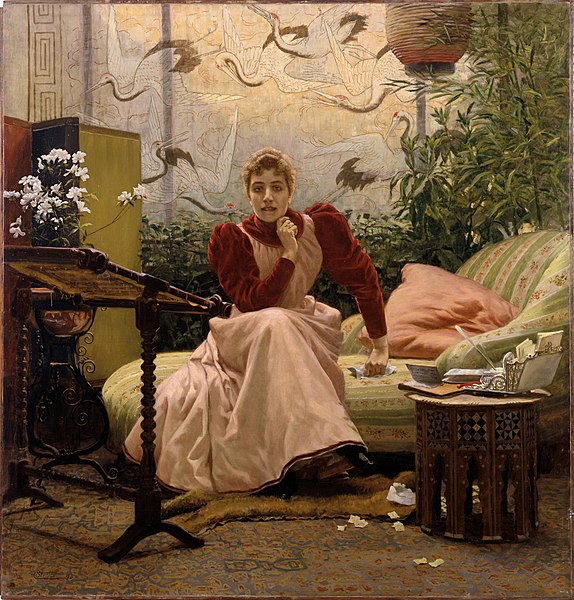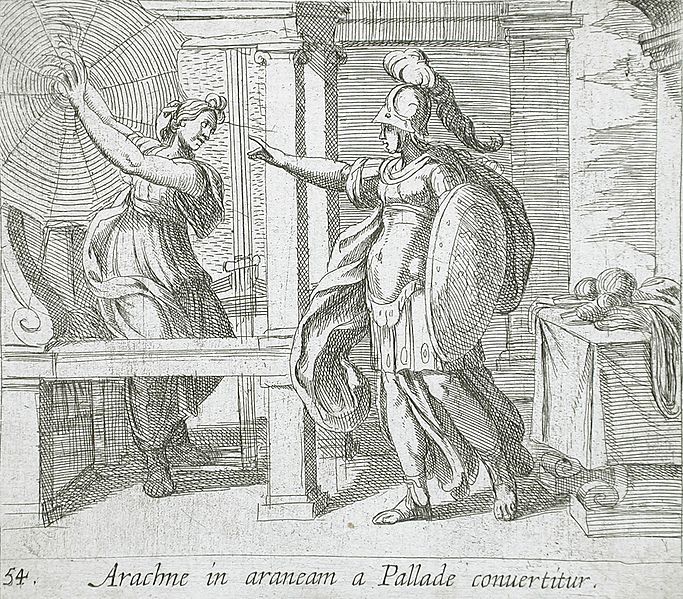Arachne—her name alone conjures up images of intricate webs and artistic mastery. But who was this audacious mortal who dared to challenge Athena, the goddess of wisdom and crafts? Let’s unravel the threads of her story, from her unparalleled weaving skills to her transformation into a creature that has become synonymous with skillful artistry.
Arachne Key Facts
| Keyword | Fact |
| Parents | Idmon and Nephela |
| Partners | None known |
| Siblings | None known |
| Offspring | Closter (According to Pliny the Elder) |
| Other Names | None |
| Roman Name | Arachne |
| Symbols | Loom, Spider |
Name and Etymology
The name “Arachne” is derived from the Greek word “Arakhnē,” which translates to “spider.” The etymology is quite fitting, given her eventual transformation into a spider, a creature known for its intricate web designs. In Roman mythology, her name remains unchanged, a testament to the enduring power of her story. Though not a hero in the traditional sense, her tale has elevated her to a status akin to one, especially in the context of cautionary myths.

Arachne Origins
Arachne was born to Idmon, a dyer in purple, and Nephela in the region of Lydia. She was a mere mortal, but her weaving skills were anything but ordinary. From a young age, she displayed an uncanny ability to weave intricate patterns that were unparalleled in their beauty and complexity.
Her talents didn’t go unnoticed; people from near and far came to witness her artistry. Yet, her skills led her to develop a sense of pride that would eventually be her downfall. She claimed her abilities surpassed even those of Athena, the goddess of wisdom and crafts, thereby inviting divine wrath.
Arachne Relationships and Offspring
When it comes to romantic entanglements, Arachne’s story is notably silent. Her narrative focuses solely on her artistic prowess and the audacity to challenge a goddess. Love interests, if any, are left in the shadows, eclipsed by her larger-than-life persona.
Similarly, there are not many mentions of Arachne having any children. One notable exception however, is found in Pliny the Elder’s Natural History. He includes mention of a son named Closter, but as far as I know, it is the only mention of him.
Depiction And Characteristics
Before her transformation, Arachne was often depicted as a young, beautiful woman engrossed in her weaving. Post-transformation, she’s represented as a spider, forever bound to her loom, weaving intricate webs.
Arachne Personality
Arachne was incredibly talented, but her talents were marred by her hubris. She was confident to the point of arrogance, believing her skills to be superior even to those of the gods. This audacity defines her character and sets the stage for her ultimate fate.
Arachne Roles And Responsibilities
Arachne’s role in mythology serves as a cautionary tale about the dangers of excessive pride and the audacity to challenge the gods. Her story is often cited as a lesson in humility, a reminder that no matter how talented one might be, there are limits to human capabilities.
Myths about Arachne
The myth of Arachne is a compelling narrative that serves as a cautionary tale about the perils of hubris. It’s a story that has been told and retold, each version adding its own nuances, but the core elements remain the same: a mortal challenges a goddess, and the consequences are both tragic and transformative.
The Weaving Contest with Athena
In the most famous version of her myth, Arachne boldly declares that her weaving skills are superior to those of Athena, the goddess of wisdom and crafts. Athena, disguised as an old woman, gives Arachne a chance to recant her boast. When Arachne doubles down, Athena reveals her true identity and accepts the challenge.
Both set to their looms with divine speed, their shuttles flying back and forth as if possessed. Athena weaves a tapestry depicting the gods in all their glory, a masterpiece that celebrates divine power and wisdom. The central scene shows Athena’s contest with Poseidon for the patronage of Athens, a contest Athena won by producing the olive tree, a symbol of peace and prosperity.
Arachne, on the other hand, chooses a more audacious theme. Her tapestry portrays the gods’ follies and indiscretions, highlighting their flaws and misdeeds. Zeus’s numerous affairs, Apollo’s cruel punishments, and even Athena’s own acts of vengeance are all laid bare in intricate detail. It’s a masterpiece, but one that mocks the gods rather than venerates them.
The Transformation
Upon seeing Arachne’s tapestry, Athena is filled with rage. Not only has a mortal dared to challenge her, but she has also insulted the gods in the process. In a fit of divine fury, Athena tears Arachne’s tapestry to shreds and strikes her on the forehead, triggering an overwhelming sense of shame and guilt in the young weaver.
Unable to bear her humiliation, Arachne attempts to hang herself. Athena, perhaps feeling a moment of pity or remorse, intervenes. She loosens the noose but declares that Arachne will hang forever. With a touch, she transforms Arachne into a spider, condemning her to a life of endless weaving.
Representations Of Arachne In Art
Arachne has been a popular subject in art, especially during the Renaissance. Artists like Velázquez have depicted her, often focusing on the moment of her transformation. These artworks serve to immortalize her story, capturing both her talent and her hubris in a single frame.
Mentions in Ancient Texts
While Ovid’s “Metamorphoses” remains the cornerstone, other ancient authors have also immortalized Arachne in their works.

Ovid’s Metamorphoses
Written around 8 AD, Ovid’s “Metamorphoses” provides the most comprehensive account of Arachne’s life, her audacious challenge to Athena, and her eventual transformation into a spider. This poetic narrative has been the primary source for understanding Arachne’s myth for centuries.
Pliny the Elder’s Natural History
Pliny the Elder, in his encyclopedic work “Natural History,” written around 77-79 AD, offers an intriguing twist to Arachne’s tale. He mentions that Arachne had a son named Closter, who is credited with inventing the spinning wheel. This detail adds a familial dimension to Arachne’s story, suggesting that her legacy might have extended through her offspring.
Hyginus’s Fabulae
The Latin author Hyginus also touches upon Arachne’s story in his work “Fabulae,” which is believed to have been written in the 1st century AD. While his account is less detailed than Ovid’s, it corroborates the essential elements of the myth, including Arachne’s audacious challenge to Athena and her subsequent transformation.
Frequently Asked Questions
Arachne is famous for her unparalleled weaving skills and her audacity to challenge Athena, which led to her transformation into a spider.
There’s no mention of Arachne having any siblings.
Her primary symbols are the loom and the spider.
No, she was a mortal who was transformed into a spider.
Her story serves as a cautionary tale about the dangers of excessive pride and challenging the gods.
Featured Image Credit: René-Antoine Houasse, Public domain, via Wikimedia Commons
